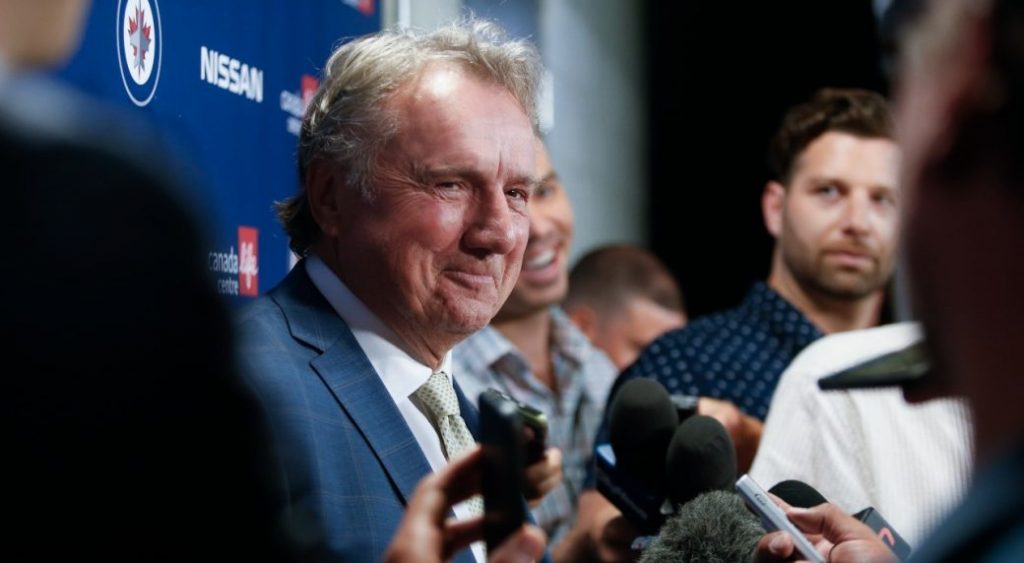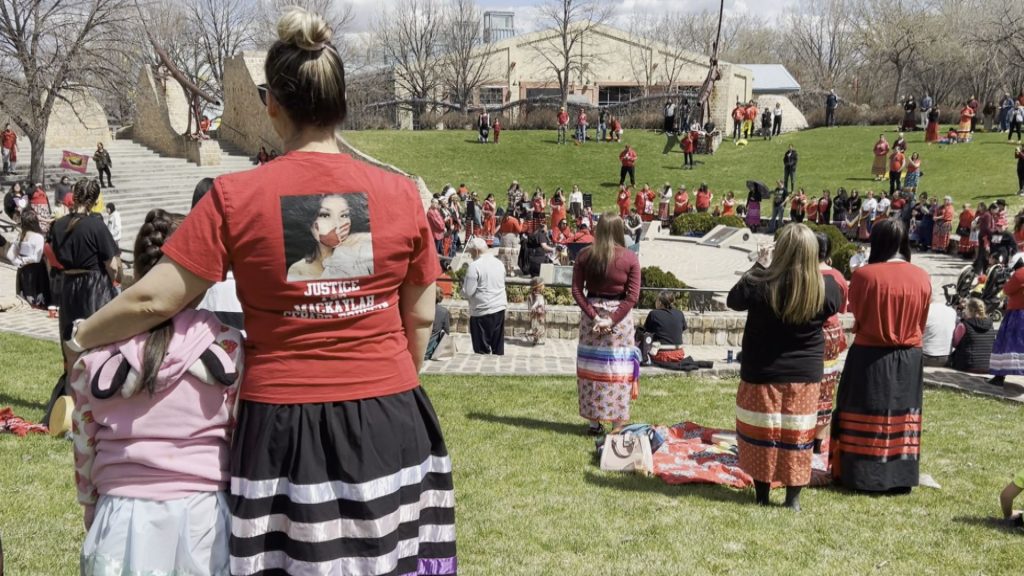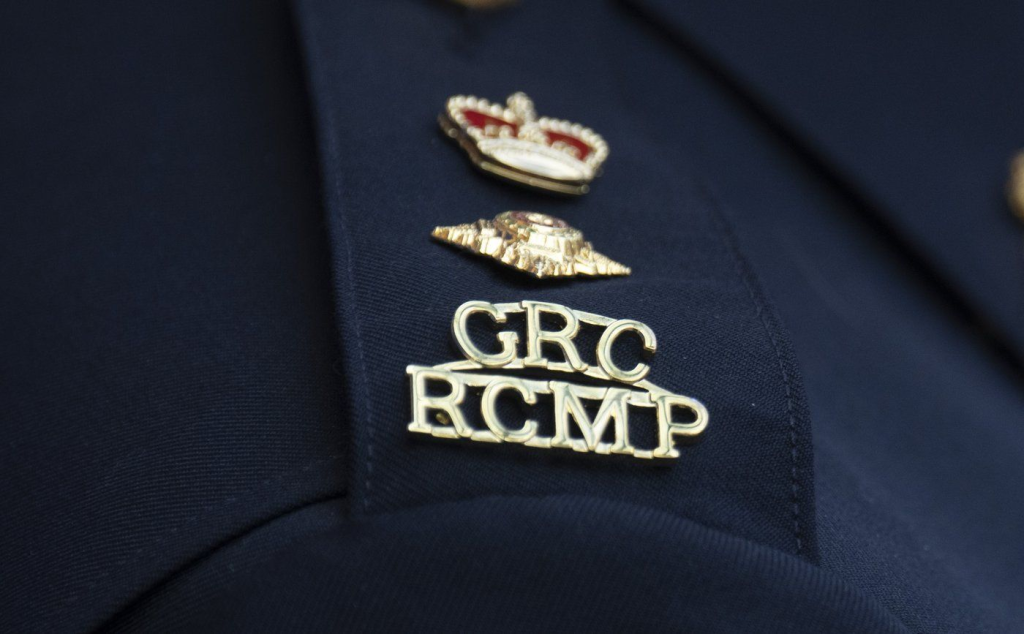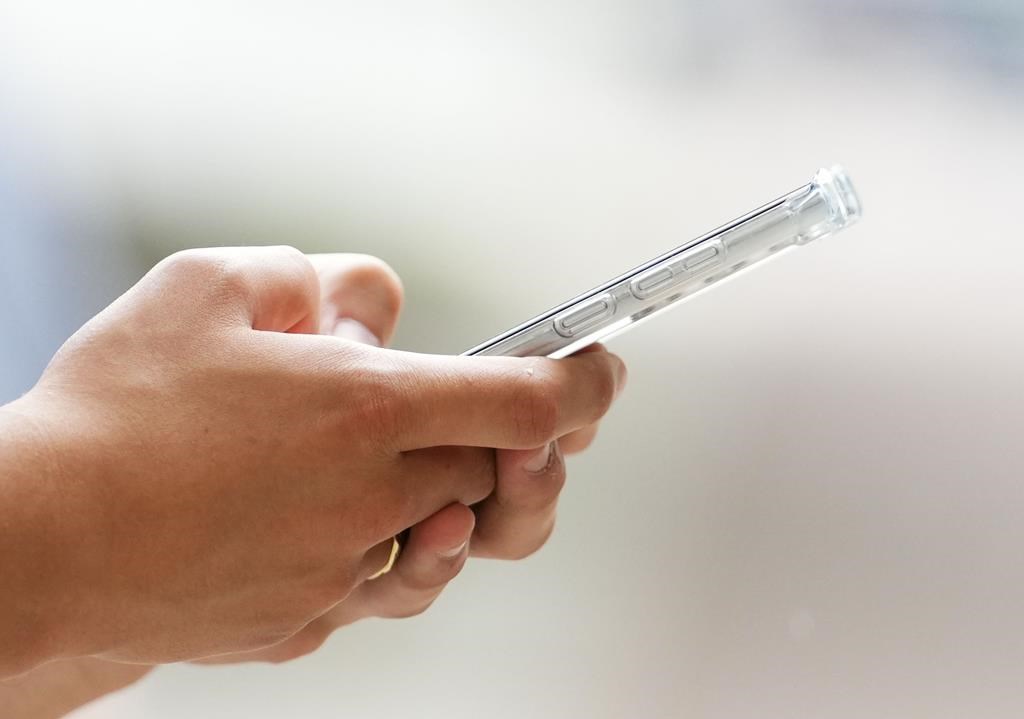Crowns, sceptres, rings, ampulla and more: The coronation regalia explained
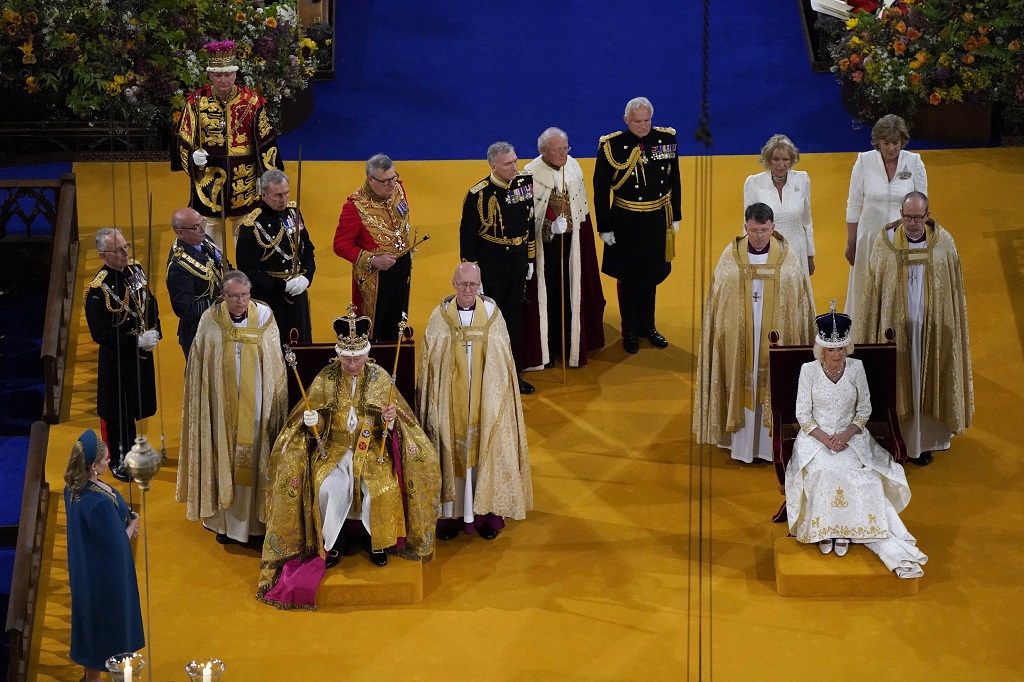
Posted April 21, 2023 8:10 am.
Last Updated May 6, 2023 3:29 pm.
King Charles III and Queen Camilla were crowned at Westminster Abbey in London, England, on May 6 – the first coronation that took place in the United Kingdom in nearly 70 years.
Although the procession and solemn ceremony — conducted by Justin Welby, the archbishop of Canterbury — were more low-key than Queen Elizabeth II’s coronation in June of 1953, it was steeped in ancient history and traditions that included royal regalia from the Crown Jewels. Most of the regalia dates back to the 17th century but at least one item is from the 12th century.
“The Coronation Regalia are sacred and secular objects which symbolize the service and responsibilities of the monarch,” Buckingham Palace states on its website.
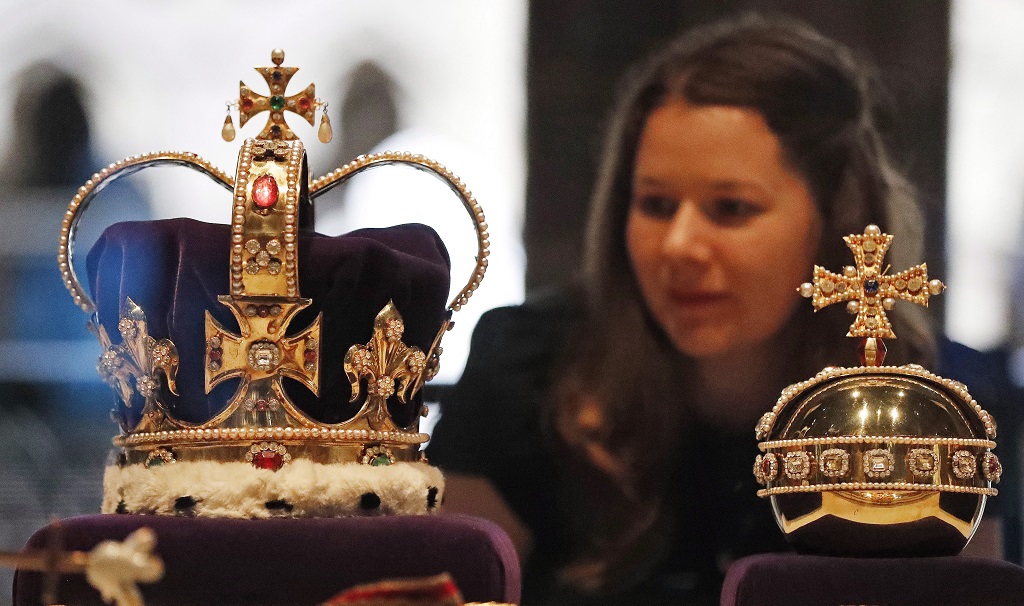
A woman looks at the St. Edward’s Crown and Orb, part of an exhibition at the The Queen’s Diamond Jubilee Galleries, in Westminster Abbey in London, England, on May 29, 2018. (AP Photo/Frank Augstein)
During the coronation ceremony, Charles was anointed with holy oil, donned with coronation attire, and then “invested” with several ornaments of symbolic value, including spurs, swords and armills, orb, ring, and sceptres. He was then crowned after the investiture.
Camilla was also anointed with holy oil. As with Charles, the Ampulla and Coronation Spoon was used during what is considered the most sacred part of the ceremony.
Charles’ regalia included St. Edward’s Crown, the Sovereign’s Ring, Sovereign’s Orb, St. Edward’s Staff, as well as five symbolic swords, the Sword of Offering, two sceptres, armills, and spurs.
Camilla’s regalia included Queen’s Mary Crown, Queen Consort’s Ring, and Queen Consort’s Rod with Dove.
Below is an explainer of some of the objects being used for the coronation.
St. Edward’s Crown and Imperial State Crown
According to tradition, St. Edward’s Crown, the centerpiece of the Crown Jewels kept at the Tower of London, was used to crown King Charles III at the coronation ceremony. It was worn by Elizabeth during her coronation in 1953 and has been refitted for her son. It is only used at the moment of crowning.
The crown is the inspiration for the official coronation emoji.
A special emoji for the Coronation has gone live today! The emoji, based on St Edward’s Crown, will appear when any of the following hashtags are used: #Coronation#CoronationConcert#TheBigHelpout#CoronationWeekend#CoronationBigLunch pic.twitter.com/ueHOpkNn6M
— The Royal Family (@RoyalFamily) April 9, 2023
The crown was initially made for King Charles II in 1661, replacing the medieval crown that was melted down in 1649 after the execution of Charles I. The medieval one is believed to date back to Edward the Confessor who ruled in the 11th century and later canonized by the pope in the 12th century.
The crown’s design features elements of the original: four crosses-pattée and four fleurs-de-lis, and two arches. The crown, which weighs nearly five pounds (2.2 kilograms), has a solid gold frame set with rubies, amethysts, sapphires, garnets, topazes and tourmalines and has a purple velvet cap and ermine band. It is topped with an orb and a cross.
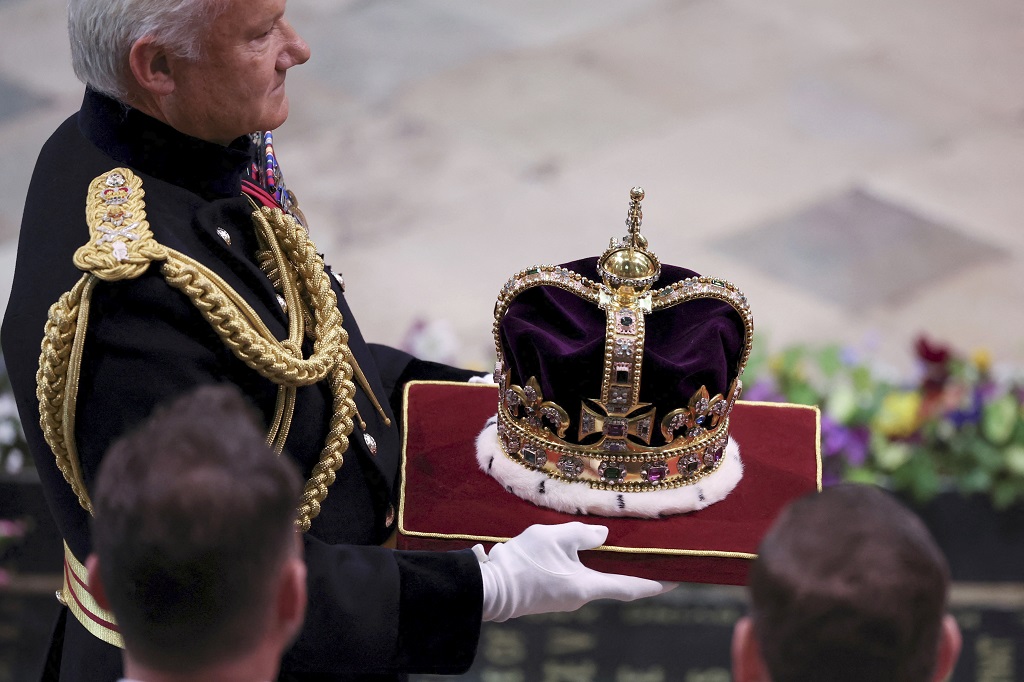
The 17th century St. Edward’s Crown is carried for Britain’s King Charles III and Queen Consort Camilla’s coronation ceremony, at Westminster Abbey, in London, on May 6, 2023. (Phil Noble/Pool Photo via AP)
Due to its weight, Charles switched to the lighter Imperial State Crown after the coronation and for the procession back to the palace.
The Imperial State Crown is used on ceremonial occasions such as the opening of Parliament. It was made for the coronation of King George VI in 1937 based on a crown designed for Queen Victoria in 1838.
It has a gold frame mounted with three large stones and set with 2,868 diamonds in silver mounts, stones in gold mounts, including 17 sapphires, 11 emeralds and 269 pearls.
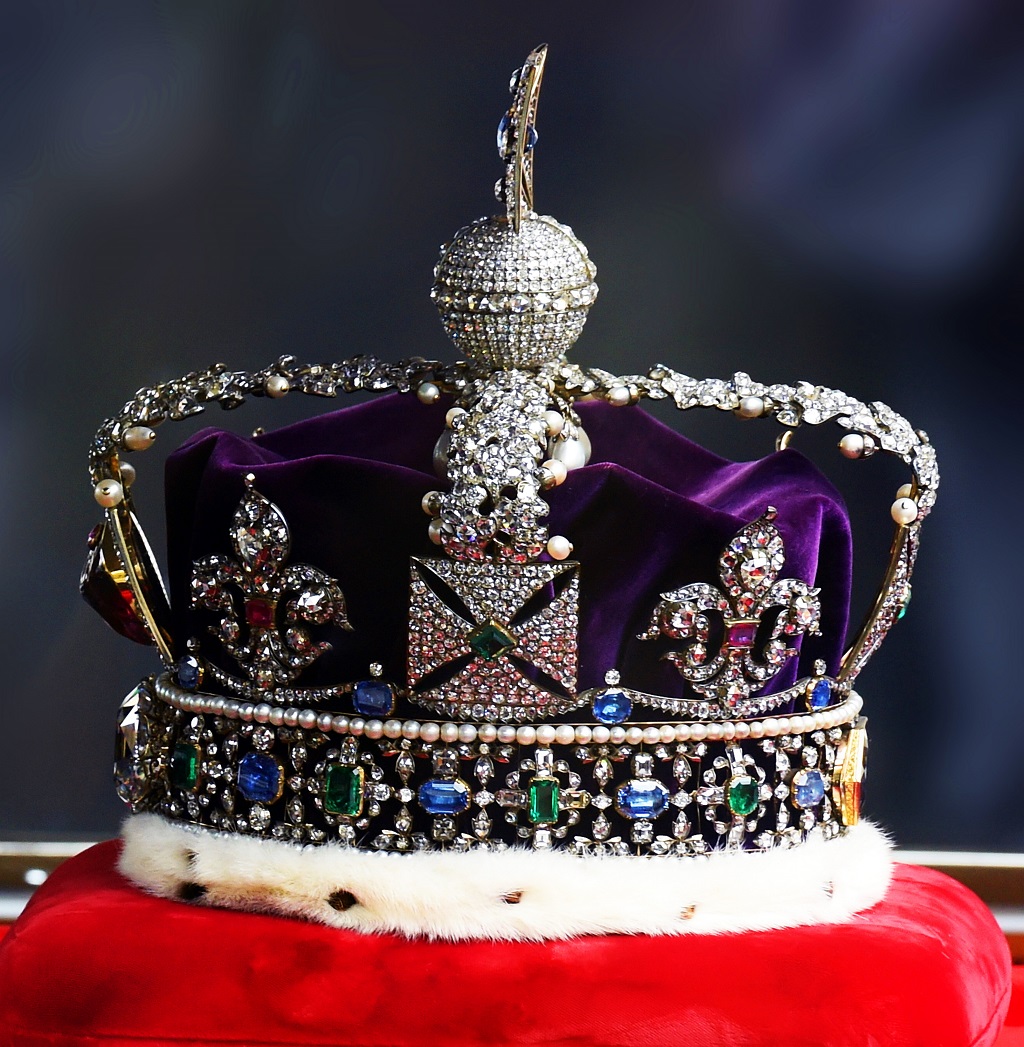
Side view of the Imperial State Crown, is one of the Crown Jewels of the United Kingdom and symbolizes the sovereignty of the monarch. (Universal Images Group, via AP)
“The term, ‘imperial state crown’ dates back to the 15th century when English monarchs chose a crown design closed by arches, to demonstrate that England was not subject to any other earthly power,” as stated on the Royal Collection Trust website.
The arches are topped by fretted silver, pavé-set with diamonds, with a cross-pattée (formation) above with an octagonal rose-cut sapphire known as St. Edward’s Sapphire set in the centre.
Ampulla, Chrism oil and Coronation Spoon
The anointing of the monarch, which is the most sacred part of the coronation ceremony, takes place before the investiture and crowning.
The holy oil, which will be used to anoint The King and The Queen Consort, was consecrated in The Church of the Holy Sepulchre in Jerusalem in March. The Archbishop will pour the oil from the Ampulla into the Coronation Spoon.
The Ampulla is made from gold in the shape of an eagle, which was made for the coronation of King Charles II in 1661.
The Coronation Spoon, which is the oldest item used during coronations, is made with gilded silver and is the only item of royal goldsmith’s work to survive from the 12th century. It was used to anoint King James I in 1603 and at every coronation thereafter.
Spurs
The two gold spurs, made for Charles II in 1661 and then altered in 1820 for George IV, features a Tudor rose and a velvet-covered strap with gold embroidery. They represent knighthood and were historically fastened to the monarch’s feet but are now held to the ankles.

A general view of the Coronation spurs at the coronation of King Charles III at Westminster Abbey, London, on May 6, 2023. (Gareth Cattermole/Pool Photo via AP)
Symbolic swords
Two maces (ornamental staffs) are invested to the monarch during the coronation, which are made of silver gilt over oak and date between 1660 and 1695. They represent the “ceremonial emblems of authority.”
Sword of State, which symbolizes “royal authority,” has a steel blade with a silver-gilt handle that is enclosed in a wooden scabbard, which carries the coat of arms of King William III, and is covered in velvet. Two of these swords were made during the reign of King Charles II in the mid-1600s, but only one survived.
The following three swords were first used at the coronation of King Charles I in 1626, with the blades dating back to the 16th century. They are carried without their scabbards.
The Sword of Temporal Justice signifies the monarch’s role as “head of the Armed Forces.
The Sword of Spiritual Justice signifies the monarch’s role as “defender of the faith.”
The Sword of Mercy has a blunted tip and symbolizes the “sovereign’s mercy.”
Two sceptres
The Sovereign’s Sceptre with Cross symbolizes the monarch’s secular power and good governance. It is a gold rod with a heart-shaped structure at the top that holds the Cullinan I diamond. It was created for King Charles II and the diamond was added in 1901.
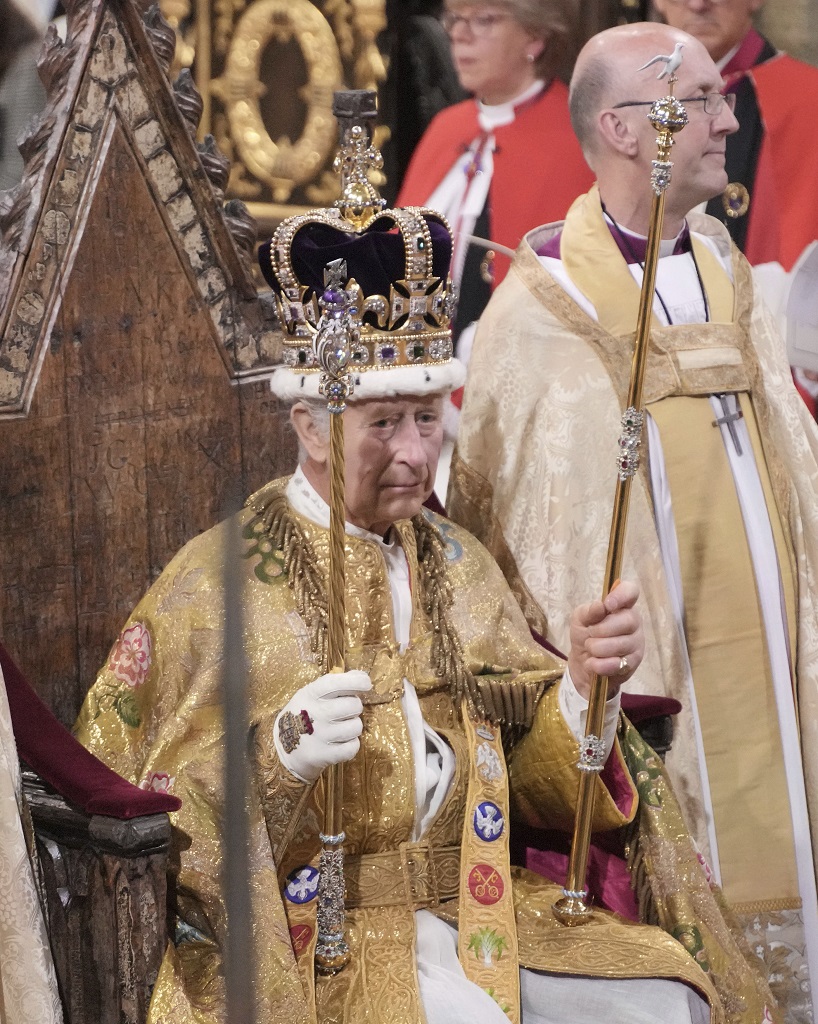
King Charles III holds holds the Sovereign’s Sceptre with Cross after he was crowned with St Edward’s Crown during the coronation ceremony at Westminster Abbey, London, on May 6, 2023. (Jonathan Brady/Pool Photo via AP)
The Sceptre with Dove, which symbolizes the spiritual role of the monarch, is also known as the “Rod of Equity and Mercy.” It was created in 1661 for King Charles II, featuring an enamelled dove with outspread wings that represents the Holy Ghost in Christianity.
Sovereign’s Ring
The sapphire ring with a ruby cross set in diamonds, which symbolizes kingly dignity, was made for King William IV for his coronation in 1831. It has been used in all coronations since King Edward VII, the son of Queen Victoria, in 1902.
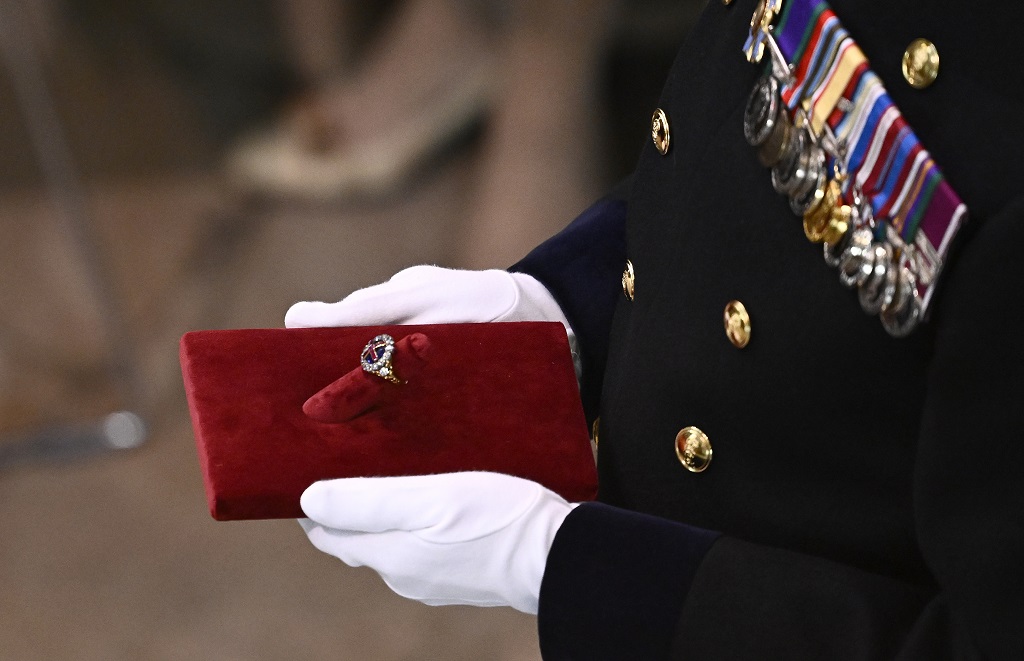
A general view of the ring symbolizing the faithful ‘marriage’ of a Monarch to his People at the coronation of King Charles III at Westminster Abbey, London, on May 6, 2023. (Gareth Cattermole/Pool Photo via AP)
Two Armills
The oval bracelets, which are presented to the monarch, are made from gold, champlevé and basse-taille enamel, with roses, thistles, fleurs-de-lis and harps, and lined in red velvet. They are believed to be related to ancient symbols of knighthood and military leadership, dating back to 1661 and used at coronations of monarchs from King Charles II until King George VI in 1937. Queen Elizabeth II used different ones at her coronation.
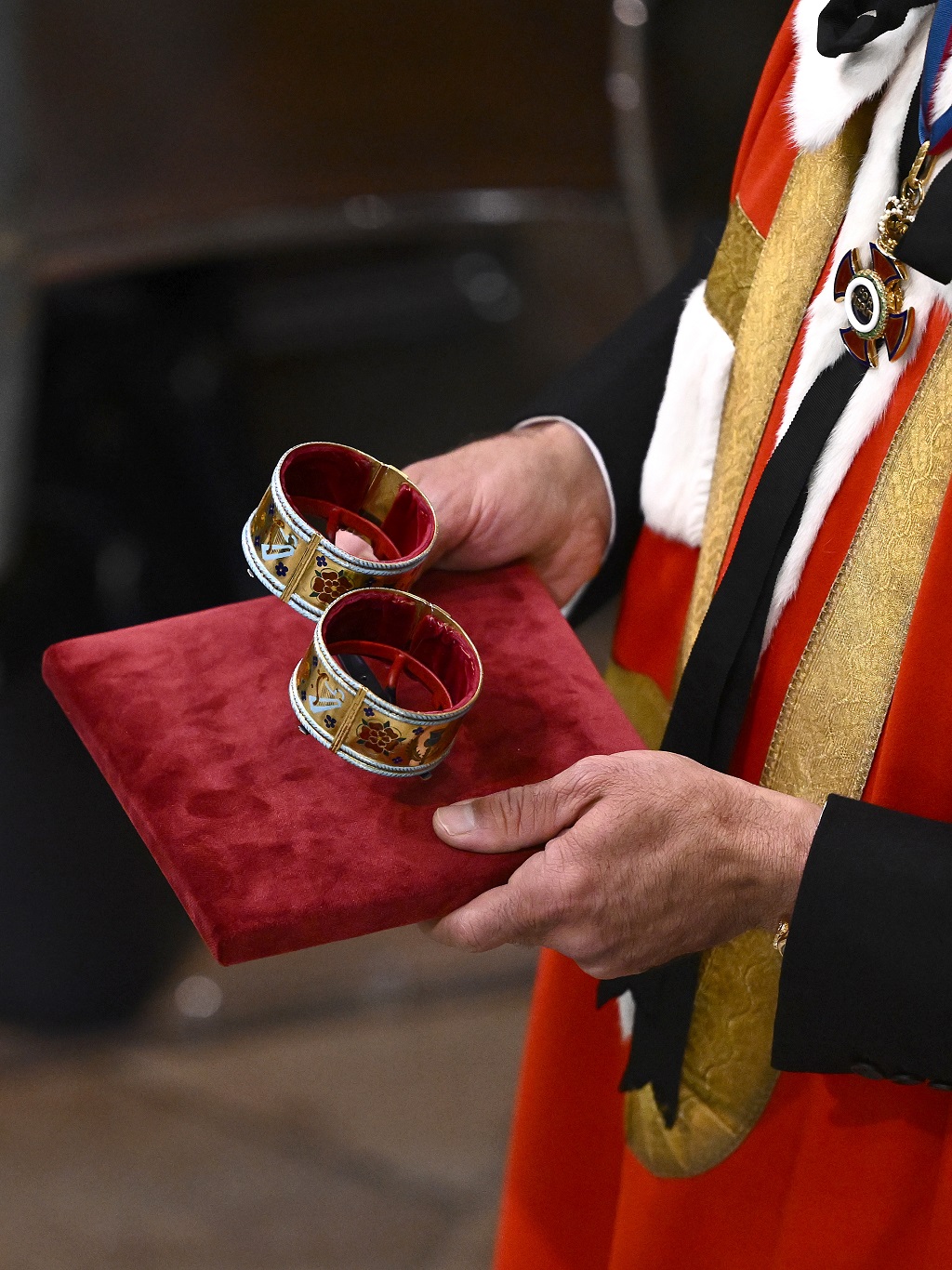
A general view of the two armills during the the coronation of King Charles III at Westminster Abbey in London on May 6, 2023. (Gareth Cattermole/Pool Photo via AP)
Sword of Offering
The monarch is “invested” with the sword, which was first used at the coronation of King George IV in the 19th century, after the anointing. It is blessed by the archbishop who then presents it to the monarch and is then offered on the alter. It was made in 1820 and has a steel blade that is mounted in gold and jewels.
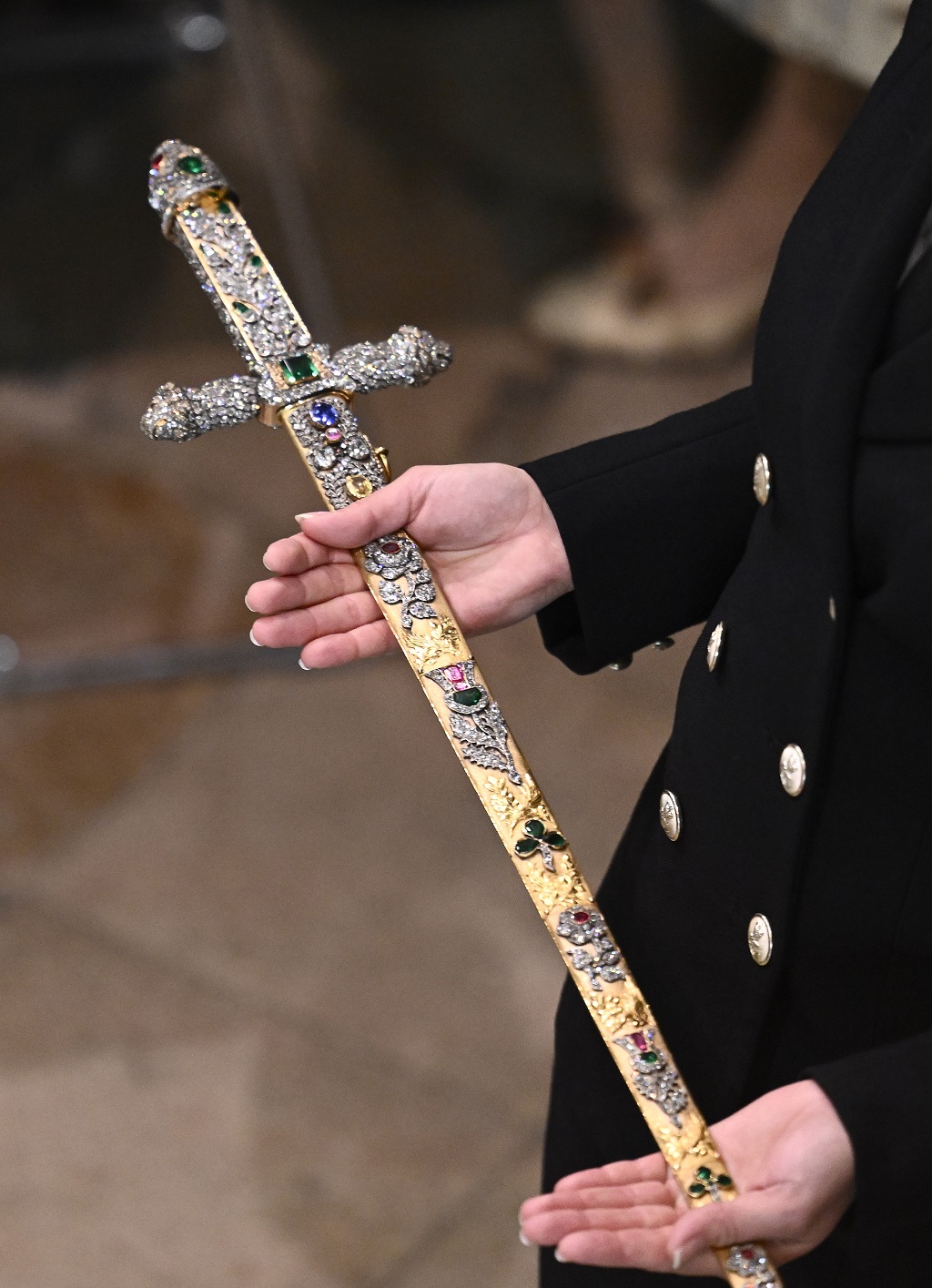
A general view of The Sword of Offering during the Coronation of King Charles III at Westminster Abbey in London, Saturday, May 6, 2023. ( Gareth Cattermole/Pool Photo via AP)
Sovereign’s Orb
The orb is made from gold with a cross at the top. It represents the power of the monarch and symbolizes Christianity. It also has three sections of jewels that represent each of the three continents from the medieval period.
During a coronation, the orb is placed in the monarch’s right hand and then placed on the altar before the crowning.

The orb is carried for Britain’s King Charles III and Queen Camilla’s coronation ceremony, at Westminster Abbey, in London, on May 6, 2023. (Phil Noble/Pool Photo via AP)
St. Edward’s Staff
The staff, which was created in 1661, is a gold rod with acanthus leaves and a steel pike at the bottom. It is also known as the Long Sceptre, associated with St. Edward (Edward the Confessor). Although its exact purpose is no longer known, it continues to be carried in coronation processions.
Queen Mary’s Crown
The crown, which was made for Queen Mary, the consort of King George V, for the coronation in 1911, has a silver frame that is lined with gold and set with 2,200 diamonds.
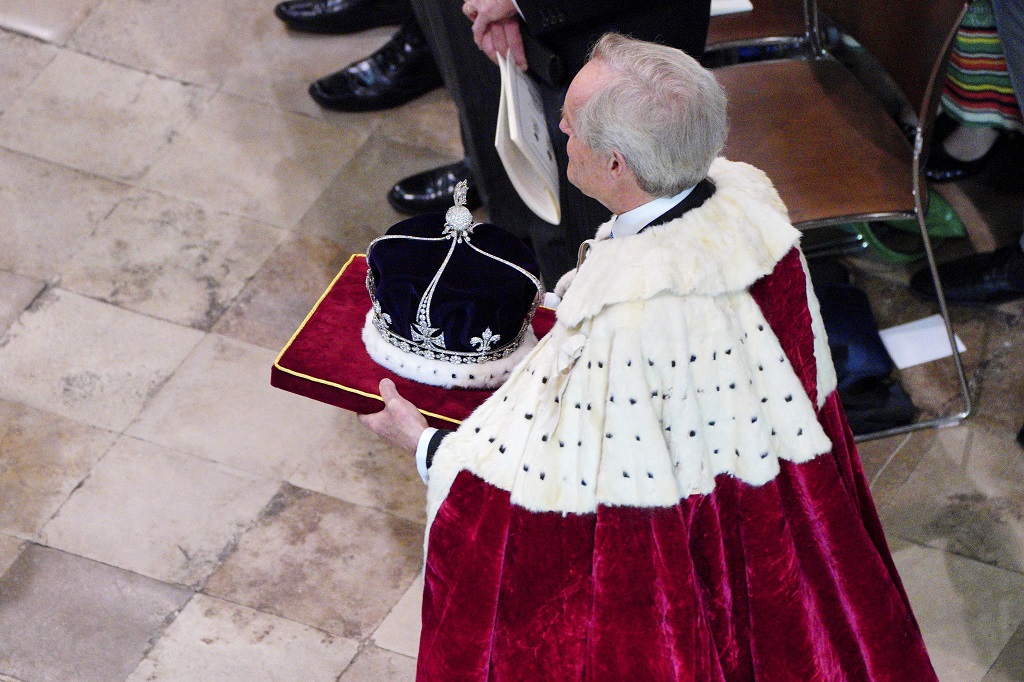
Queen Mary’s Crown is carried during the coronation ceremony of Britain’s King Charles III at Westminster Abbey in London on May 6, 2023. (Ben Birchall/Pool via AP)
“The choice of Queen Mary’s Crown by Her Majesty is the first time in recent history that an existing crown will be used for the Coronation of a Consort instead of a new commission being made,” Buckingham Palace says on its website.
A couple of additions were added to the crown for the 2023 coronation, such as the Cullinan III, IV and V diamonds from Queen Elizabeth II’s personal collection, and the removal of four of the eight detachable arches.
Queen Consort’s Ring
A ruby ring set in gold, which was made for the coronation of William IV and Queen Adelaide in 1831, and used by three subsequent Queens Consorts — Queen Alexandra, Queen Mary, and The Queen Mother.
Queen Consort’s Rod with Dove
The design is based on the Sovereign’s Sceptre with Dove and was initially made for the Mary of Modena, Queen Consort of James II, in 1685. The sceptre, which is made of ivory, is viewed as controversial because Britain has a near-total ban on dealing elephant ivory products. Prince William has also campaigned against illegal animal part trafficking.
With files from the Associated Press, Buckingham Palace, and the Royal Collection Trust
